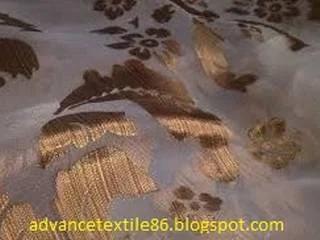Devore fabric
The Devore fabric method is used exclusively in velvets, where a blended-fiber material
undergoes a chemical process to dissolve cellulose fibers to create a
semi-transparent pattern against more tightly woven fabrics. The same method
can be used for fabrics other than velvet, such as lace or burnout T-shirt
fabrics.
History of Devore
Burnout/Devore fabrics are thought to have originated in France, probably as a cheaper alternative to lace that can be made using caustic paste in fabrics. The commercial chemical process used in fashion clothing developed in Lyon in the 19th and early 20th centuries. The technique became popular in the 1920s - commonly used in evening gowns and shawls - and was revived in the 1980s and The 90s, especially by Georgina von Etzdorf in evening wear and scarves after the Jasper Conran drama dress.
Founded
in 1981 as the Wiltshire Textile Printing Workshop, Georgina von Etzdorf's primary focus was on creating color effects on fabrics. With credit for
popularizing the velvet scarf, he introduced Devore to the range in 1993 -
experimenting with printed velvet since 1985.
Manufacturing process
Devore fabric techniques use blended fabrics that combine protein-based fibers like silk and
cellulose-based fibers like viscose, cotton, or rayon. To create a ‘burnout’
pattern, a chemical gel containing sodium hydrogen sulfate is applied to the
fabrics, dissolving the cellulose-based fibers and leaving the protein-based
fibers unaffected by the chemical. The chemical gel can be applied by printing
or by hand painting on the fabric.
Devore printing procedure and recipe
There
are two types of printing recipes, such as below-
For Cellulose Devore
The
removal of cellulose fibers from a mixed fiber woven/knitted fabric.
Recipe
Aluminum sulfate 20gms
Glycerine 2gms
Thickener 60gms
Water 18gms
Total 100gms
Print sequence/procedure
Dry
Bake = 140
degrees for 5 minutes or until ‘burnt’ brown color
Brush = out the fibers. Wear a face mask
Wash = out any remaining chemicals and loose fibers
For Protein Devore
The
removal of protein fibers like silk, wool, etc. from the mixed fiber is
woven/knitted fabric.
Recipe
Caustic
soda (Sodium Hydroxide) 30gms
Water
19gms
Perminol
KP
1gm
Thickener 50gms Indalca
Total
100gms
Print sequence/procedure
Dry
Steam =
100 degrees for 15 minutes
Wash =
for a minimum of 15 minutes. Take care when washing, caustic soda burns.
Conclusion
Historically,
the woven Devore fabric was deliberately created to mimic the design of
jacquard woven fabrics, in some cases, it is seen that the process was actually
performed on jacquard woven fabrics. The result is a tradition to distinguish a
Devore fabric from a traditional woven textile, for example, a cut velvet the fabric of a Devore velvet fabric, often simply by looking closely at the weave
configuration.









0 Comments